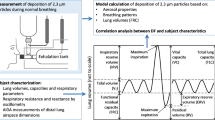Abstract
TSI Nanoparticle Surface Area Monitor (NSAM) Model 3550 has been developed to measure the nanoparticle surface area deposited in different regions of the human lung. It makes use of an adjustable ion trap voltage to match the total surface area of particles, which are below 100 nm, deposited in tracheobronchial (TB) or alveolar (A) regions of the human lung. In this paper, calibration factors of NSAM were experimentally determined for particles of different materials. Tests were performed using monodisperse (Ag agglomerates and NaCl, 7–100 nm) and polydisperse particles (Ag agglomerates, number count mean diameter below 50 nm). Experimental data show that the currents in NSAM have a linear relation with a function of the total deposited nanoparticle surface area for the different compartments of the lung. No significant dependency of the calibration factors on particle materials and morphology was observed. Monodisperse nanoparticles in the size range where the response function is in the desirable range can be used for calibration. Calibration factors of monodisperse and polydisperse Ag particle agglomerates are in good agreement with each other, which indicates that polydisperse nanoparticles can be used to determine calibration factors. Using a CFD computer code (Fluent) numerical simulations of fluid flow and particle trajectories inside NSAM were performed to estimate response function of NSAM for different ion trap voltages. The numerical simulation results agreed well with experimental results.
Similar content being viewed by others
References
Baltensperger U., Gäggeler H.W., Jost D.T. (1988). The epiphaniometer, a new device for continuous aerosol monitoring. J. Aerosol Sci. 19(7):931–934
Brunauer S., Emmett P.H., Teller E. (1938). Adsorption of gases in multimolecular layers. J. Am Chem. Soc. 60:309–319
Donaldson K., Li X.Y., MacNee W. (1998). Ultrafine (nanometer) particle mediated lung injury. J. Aerosol Sci. 29(5–6):553–560
Fissan H. & T. Kuhlbusch, 2005. Strategies and instrumentation for nanoparticle exposure control in air at workplaces. 2nd International symposium on nanotechnology and occupational health, Minneapolis, USA, October 3–6, 2005
Fissan H., A. Trampe, S. Neunman, D.Y.H Pui & W.G. Shin, 2006. Rationale and principle of an instrument measuring lung deposition area. J. Nanoparticle Research (this issue)
Han H.S., Chen D.R., Anderson B.E., Pui D.Y.H. (2000). A nanometer aerosol size analyzer (nASA) for rapid measurement of high concentration size distributions. J. Nanoparticle Res. 2:43–52
Heyder J., Gebhart J., Rudolf G., Schillerd C.F., Stahlhofen W. (1986). Deposition of particles in the human respiratory tract in the size range 0.005–15μm. J. Aerosol Sci. 17:811–825
ICRP. (1994). International Commission on Radiological Protection Publication 66 Human Respiratory Tract Model for Radiological Protection. Oxford, Pergamon, Elsevier Science Ltd
James A.C., M.R. Bailey & M-D. Dorrian, 2000. LUDEP Software, Version 2.07: Program for implementing ICRP-66 Respiratory tract model. RPB, Chilton, Didcot, OXON. OX11 ORQ UK
Jung H.J., Kittelson D.B. (2005). Characterization of aerosol surface instruments in transition regime. Aerosol Sci. Tech. 39(9):902–911
Kaufman S.L., A. Medved, A. Pöcher, N. Hill, R. Caldow & F.R. Quant, 2002. An electrical aerosol detector based on the corona-jet charger. AAAR conference (poster)
Ku B.K., Maynard A.D. (2005). Generation and investigation of airborne Ag nanoparticles with specific size and morphology by homogeneous nucleation, coagulation and sintering. J Aerosol Sci. 36(9):1108–1124
Liu B.Y.H., Pui D.Y.H. (1977). On unipolar diffusion charging of aerosols in the continuum regime. J. Colloid Interface Sci. 58:142–149
Maynard A.D., Kuempel E.D. (2005). Airborne nanostructured particles and occupational health. J. Nanoparticle Res. 7(6):587–614
Maynard A.D., 2003. Estimating aerosol surface area from number and mass concentration measurements. Ann. Occup. Hygiene 47, 123–144
Medved A., Dorman F., Kaufman S.L., Pöcher A. (2000). A new corona-based charger for aerosol particles. J. Aerosol Sci. 31(S.1):616–617
Oberdorster G., Gelein R.M., Ferin J., Weiss B. (1995). Association of particulate air pollution and acute mortality: involvement of ultrafine particles. Inhal. Toxicol. 7:111–124
Oberdorster G. (1996). Significance of particle parameters in the evaluation of exposure-dose-response relationships of inhaled particles. Particulate Sci. Technol. 14(2):135–151
Oberdörster G., Oberdörster E., Oberdörster J. (2005). Invited review: Nanotechnology: an emerging discipline evolving from studies of ultrafine particles. Environ. Health Perspect. 113(7):823–839
Shi J.P., Harrison R.M., Evans D. (2001). Comparison of ambient particle surface area measurement by epiphaniometer and SMPS/APS. Atmospheric Environment 35 (35):6193–6200
Tang I.N., Munkelwitz H.R., Davis J.G. (1977). Aerosol growth studies—II. Preparation and growth measurements of monodisperse salt aerosols. J. Aerosol Sci. 8(3):149–159
Wilson W.E., H.-S. Han, J. Stanek, J. Turner & D.Y.H. Pui, 2003. The Fuchs surface area measured by charge acceptance of atmospheric particles may be a useful indicator of the quantity of particle surface area deposited in the lung. Abstracts of the European aerosol conference. S421-S422. Madrid, Spain
Wilson W.E., H.-S. Han, J. Stanek, J. Turner, D.-R. Chen & D.Y.H. Pui, 2004. Use of electrical aerosol detector as an indicator for the total particle surface area deposited in the lung. Symp. On air quality measurement methods and technology sponsored by air and waste management association. Research triangle park, NC. Paper #37.
Woo K.-S., Chen D.-R., Pui D.Y.H., Wilson W.E. (2001). Use of continuous measurements of integral aerosol parameters to estimate particle surface area. Aerosol Sci. Tech. 34:57–65
Acknowledgements
The authors wish to acknowledge the University of Minnesota Supercomputer Institute for providing the computation time for this project.
Author information
Authors and Affiliations
Corresponding author
Rights and permissions
About this article
Cite this article
Shin, W.G., Pui, D.Y.H., Fissan, H. et al. Calibration and numerical simulation of Nanoparticle Surface Area Monitor (TSI Model 3550 NSAM). J Nanopart Res 9, 61–69 (2007). https://doi.org/10.1007/s11051-006-9153-y
Received:
Accepted:
Published:
Issue Date:
DOI: https://doi.org/10.1007/s11051-006-9153-y




